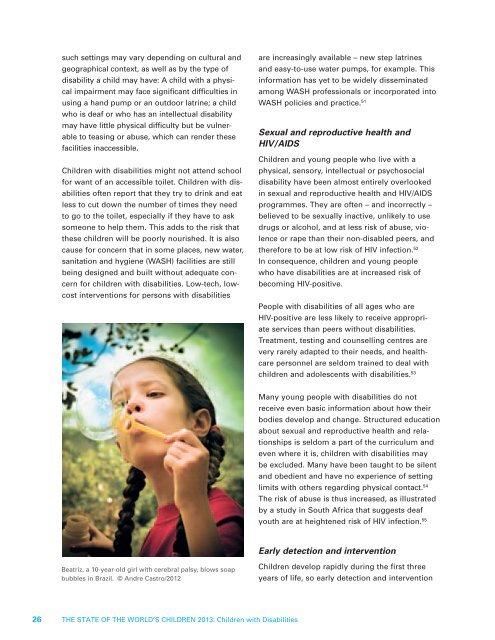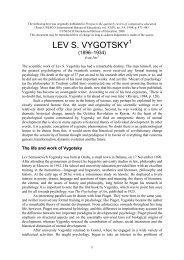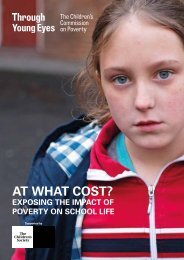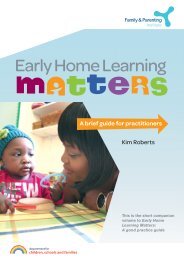Children with Disabilities
Children with Disabilities
Children with Disabilities
You also want an ePaper? Increase the reach of your titles
YUMPU automatically turns print PDFs into web optimized ePapers that Google loves.
26<br />
such settings may vary depending on cultural and<br />
geographical context, as well as by the type of<br />
disability a child may have: A child <strong>with</strong> a physical<br />
impairment may face significant difficulties in<br />
using a hand pump or an outdoor latrine; a child<br />
who is deaf or who has an intellectual disability<br />
may have little physical difficulty but be vulnerable<br />
to teasing or abuse, which can render these<br />
facilities inaccessible.<br />
<strong>Children</strong> <strong>with</strong> disabilities might not attend school<br />
for want of an accessible toilet. <strong>Children</strong> <strong>with</strong> disabilities<br />
often report that they try to drink and eat<br />
less to cut down the number of times they need<br />
to go to the toilet, especially if they have to ask<br />
someone to help them. This adds to the risk that<br />
these children will be poorly nourished. It is also<br />
cause for concern that in some places, new water,<br />
sanitation and hygiene (WASH) facilities are still<br />
being designed and built <strong>with</strong>out adequate concern<br />
for children <strong>with</strong> disabilities. Low-tech, lowcost<br />
interventions for persons <strong>with</strong> disabilities<br />
Beatriz, a 10-year-old girl <strong>with</strong> cerebral palsy, blows soap<br />
bubbles in Brazil. © Andre Castro/2012<br />
THE STATE OF THE WORLD’S CHILDREN 2013: <strong>Children</strong> <strong>with</strong> <strong>Disabilities</strong><br />
are increasingly available – new step latrines<br />
and easy-to-use water pumps, for example. This<br />
information has yet to be widely disseminated<br />
among WASH professionals or incorporated into<br />
WASH policies and practice. 51<br />
Sexual and reproductive health and<br />
HIV/AIDS<br />
<strong>Children</strong> and young people who live <strong>with</strong> a<br />
physical, sensory, intellectual or psychosocial<br />
disability have been almost entirely overlooked<br />
in sexual and reproductive health and HIV/AIDS<br />
programmes. They are often – and incorrectly –<br />
believed to be sexually inactive, unlikely to use<br />
drugs or alcohol, and at less risk of abuse, violence<br />
or rape than their non-disabled peers, and<br />
therefore to be at low risk of HIV infection. 52<br />
In consequence, children and young people<br />
who have disabilities are at increased risk of<br />
becoming HIV-positive.<br />
People <strong>with</strong> disabilities of all ages who are<br />
HIV-positive are less likely to receive appropriate<br />
services than peers <strong>with</strong>out disabilities.<br />
Treatment, testing and counselling centres are<br />
very rarely adapted to their needs, and healthcare<br />
personnel are seldom trained to deal <strong>with</strong><br />
children and adolescents <strong>with</strong> disabilities. 53<br />
Many young people <strong>with</strong> disabilities do not<br />
receive even basic information about how their<br />
bodies develop and change. Structured education<br />
about sexual and reproductive health and relationships<br />
is seldom a part of the curriculum and<br />
even where it is, children <strong>with</strong> disabilities may<br />
be excluded. Many have been taught to be silent<br />
and obedient and have no experience of setting<br />
limits <strong>with</strong> others regarding physical contact. 54<br />
The risk of abuse is thus increased, as illustrated<br />
by a study in South Africa that suggests deaf<br />
youth are at heightened risk of HIV infection. 55<br />
Early detection and intervention<br />
<strong>Children</strong> develop rapidly during the first three<br />
years of life, so early detection and intervention






